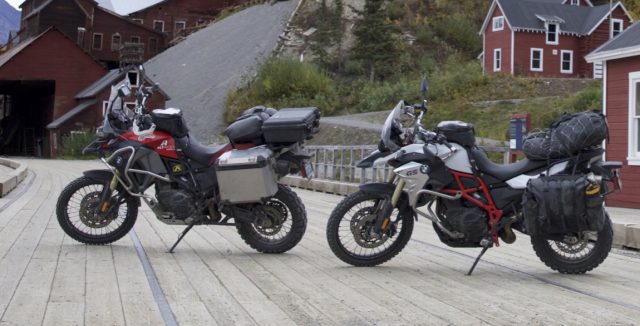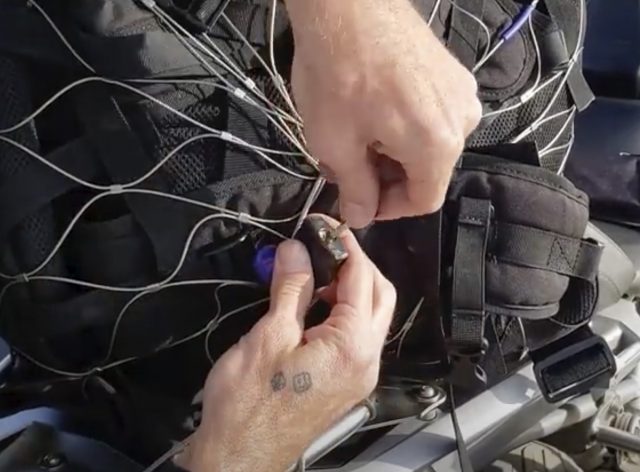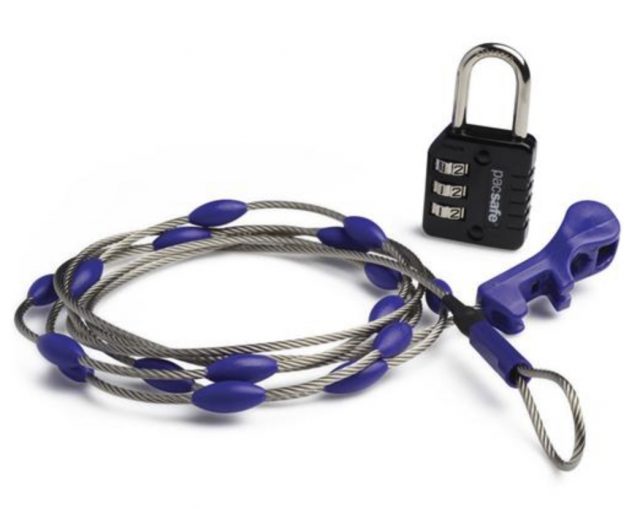When my husband, Dave, and I were planning our round-the-world trip, one of our biggest conundrums was how to ensure our valuable items were theftproof on our motorcycles when we weren’t there. Helmets, riding jackets, tank bags—we didn’t want to walk around with that stuff all day. For solo travelers, it’s even harder; they don’t have anyone to watch their things while they go into the bank or take an off-bike excursion.

Our bikes and gear in Alaska
First and foremost, use common sense. If you’re in a high-theft area or are parking your bike somewhere overnight, don’t leave anything attached if you can help it. Given enough time, thieves can steal anything, even if it’s “theftproof.” The key is not to make it so easy that they can just grab something and go.
Next, scan your bike for anything else that’s removable, like your GPS, cell phone, even the holder for your phone. I once forgot about a GoPro attached to the crash bars of my G 650 GS, and it was gone by the time I got back. Remember those gloves, too. I had a habit of shoving mine behind my windscreen until I realized that even stinking of sweat, someone might still want a free pair of gloves.
Take these items with you in a backpack or lock them in your panniers.
Riding Suits and Boots
What if you want to go for a hike? Or it’s hot, and you’ve changed out of your riding suit and boots into shorts and flip-flops? We carried duffel bags that sat on a luggage rack. The bags had enough room to shove riding jackets inside. Our boots we would strap to the sides of the duffel, then everything would get ensnared in a cabled net. We used this one, which is also great for backpacks. You can find these at your local outdoor retailer or online. They run about $70-80, which isn’t cheap, but neither is having your gear stolen and replacing it all. Get the largest one you can find, as you’ll always want to stuff more under there than you think. Ours were 55 liters.

Pac Safe Bag Protector
Although the protector is made of steel, it’s lightweight at just over a pound. It also comes with a padlock. The storage pouch was too small for my liking. I gave up wrestling with that on Day One. The net pops like a jack-in-the-box once removed and is too hard to wrangle back inside. When not in use, I kept the bag protector netting laid out in the bottom of my duffel, where it took up little room and was easy to pull out when needed.
The locking mechanism can be user-error faulty. Make sure you’re synching the net as tight as possible, or someone can pull a jacket or even the duffel bag out. You’ll also want to make sure the opening is under the protector, and the longer cable used to fasten the net to the bike is woven through that, synched and locked to something that isn’t easily removable. Your bike’s frame is pretty much the only place I’d recommend. Even luggage racks can be removed with the right tools or sawed into.
As a bonus, the net holds everything in place and keeps it from flying off your bike, so you can use it while riding, too.
Here’s a great video on how the bag protector works.
You can also use a lock strap passed through your helmet and the sleeve of your riding jacket, fixed to your bike.
Tank Bags
Unless they’re a custom home-job, tank bags are always made from soft fabric in case they hit you in the gut (or other nether regions) on bumpy terrain. I used to take my tank bag with me but got tired of messing with the zipper, which became askew the more I zipped the bag on and off. Dave would lock his zippers together with a small padlock. Tank bags are tough to secure unless you take them with you, so I used them to store less valuable things, like snacks, a T-shirt, even flip-flops. Basically, if it was staying on my bike, I left nothing in it that would break my heart to lose. While riding, I kept my camera inside the tank bag, but when off-bike that came with me in a backpack, along with my wallet.
You could lock the tank bag to your handlebars with a cable, provided it has a place to attach it to, but most I’ve seen are metal clasps on fabric, which are easy to cut.
Helmets
I recommend a lock strap. Like locks for bicycles, lock straps are very hard to cut through, but ones made specifically for helmets are lighter than bike locks, weighing under a pound. I place my helmet on my handlebars, then wrap the strap around my bar mount. I’ve also seen people stick their helmets on the passenger footpeg and lock it to the frame. Send the cable through the mouth guard, not the chinstrap clasp, as that can be cut. No matter where you lock your helmet, make sure it’s not near the exhaust. Also, close your visor. If it rains or a bird decides to let loose at just the right moment, at least the inside of your lid is not wet. Don’t forget to take or stow your Bluetooth or helmet cam.

Lock strap
Side Cases
Hard case panniers can help tremendously with all of the above, but there are pros and cons to hard cases, and I prefer soft bags. For these, we again used Pac-safe cables and wound them around the bags, synched them tight, and secured them to the frame or rack. Get the longest one you can find. We needed one for each side, so two per person.

Pac safe cables
The weight does start to add up when you’re protecting your gear from theft and need to carry cables and locks, but it’s not a ton. In the end, the protection is worth it for the peace of mind knowing your valuables are secure.
Our No Compromise Clause: We carefully screen all contributors to make sure they are independent and impartial. We never have and never will accept advertorial, and we do not allow advertising to influence our product or destination reviews.

